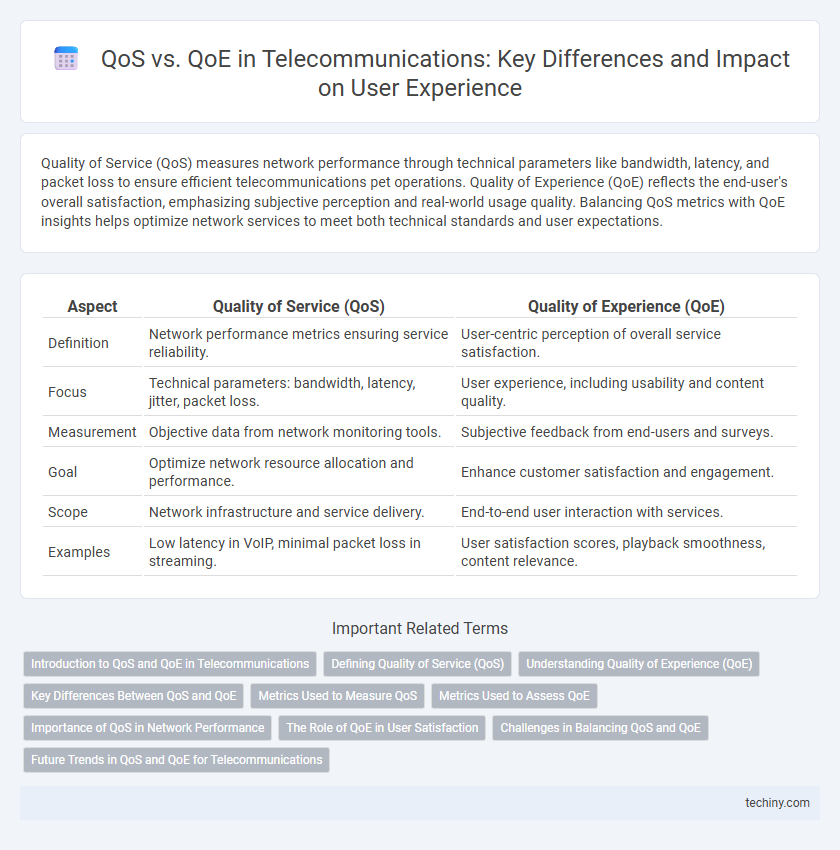Quality of Service (QoS) measures network performance through technical parameters like bandwidth, latency, and packet loss to ensure efficient telecommunications pet operations. Quality of Experience (QoE) reflects the end-user's overall satisfaction, emphasizing subjective perception and real-world usage quality. Balancing QoS metrics with QoE insights helps optimize network services to meet both technical standards and user expectations.
Table of Comparison
| Aspect | Quality of Service (QoS) | Quality of Experience (QoE) |
|---|---|---|
| Definition | Network performance metrics ensuring service reliability. | User-centric perception of overall service satisfaction. |
| Focus | Technical parameters: bandwidth, latency, jitter, packet loss. | User experience, including usability and content quality. |
| Measurement | Objective data from network monitoring tools. | Subjective feedback from end-users and surveys. |
| Goal | Optimize network resource allocation and performance. | Enhance customer satisfaction and engagement. |
| Scope | Network infrastructure and service delivery. | End-to-end user interaction with services. |
| Examples | Low latency in VoIP, minimal packet loss in streaming. | User satisfaction scores, playback smoothness, content relevance. |
Introduction to QoS and QoE in Telecommunications
Quality of Service (QoS) in telecommunications refers to the technical parameters and metrics such as bandwidth, latency, jitter, and packet loss that determine the network's ability to deliver consistent and reliable connectivity. Quality of Experience (QoE) measures the end-user's overall satisfaction with the service, encompassing factors like video streaming quality, call clarity, and application responsiveness. Understanding the distinction between QoS and QoE is essential for optimizing network performance and enhancing user satisfaction in telecommunications.
Defining Quality of Service (QoS)
Quality of Service (QoS) in telecommunications refers to the network's ability to guarantee specific performance metrics such as latency, jitter, bandwidth, and packet loss, ensuring reliable and efficient data transmission. QoS mechanisms prioritize traffic types to maintain consistent service levels for critical applications like voice and video communication. This technical framework differs from Quality of Experience (QoE), which measures the end-user's perceived satisfaction with the service.
Understanding Quality of Experience (QoE)
Quality of Experience (QoE) in telecommunications measures user satisfaction with a service, emphasizing subjective perception over technical metrics. Unlike Quality of Service (QoS), which focuses on network parameters like latency, jitter, and packet loss, QoE integrates factors such as content relevance, device performance, and user expectations. Accurate assessment of QoE requires combining network analytics with user feedback to enhance service delivery and optimize overall customer experience.
Key Differences Between QoS and QoE
Quality of Service (QoS) in telecommunications refers to the technical parameters such as latency, bandwidth, and packet loss that measure network performance objectively. Quality of Experience (QoE) evaluates the end-user's overall satisfaction with the service, incorporating subjective factors like usability, video clarity, and audio quality. While QoS focuses on network-centric metrics, QoE emphasizes user perception and interaction, highlighting the importance of aligning network performance with user expectations.
Metrics Used to Measure QoS
Quality of Service (QoS) in telecommunications is measured using metrics such as latency, jitter, packet loss, and bandwidth, which quantify network performance parameters. These metrics ensure efficient data transmission, minimizing delays and errors to maintain service stability. Accurate measurement of QoS metrics directly impacts the overall network reliability and user experience quality.
Metrics Used to Assess QoE
Quality of Experience (QoE) metrics encompass subjective and objective measurements such as Mean Opinion Score (MOS), Video Quality Metrics (VQM), and Application Performance Index (Apdex) that assess user satisfaction directly. Unlike Quality of Service (QoS), which focuses on network parameters like latency, jitter, and packet loss, QoE metrics evaluate the end-user perceptual experience, combining technical performance with user feedback. Effective QoE assessment relies on real-time data analytics and user behavior insights to optimize telecommunications service delivery and enhance customer retention.
Importance of QoS in Network Performance
Quality of Service (QoS) is critical in telecommunications for ensuring reliable network performance by managing bandwidth, latency, jitter, and packet loss, which directly affect data transmission efficiency. Effective QoS protocols prioritize network traffic to maintain service levels for voice, video, and data applications, reducing congestion and minimizing interruptions. High QoS enables consistent connectivity and optimal performance, which forms the foundation for an enhanced Quality of Experience (QoE) for end users.
The Role of QoE in User Satisfaction
Quality of Experience (QoE) plays a critical role in user satisfaction by directly measuring how telecom services meet users' expectations and perceptions, beyond traditional Quality of Service (QoS) metrics like latency and throughput. Unlike QoS, which focuses on network performance parameters, QoE evaluates real-world user interactions, encompassing factors such as video streaming quality, voice clarity, and application responsiveness. Enhancing QoE leads to improved customer retention and loyalty, driving service providers to optimize network resources and design user-centric services.
Challenges in Balancing QoS and QoE
Balancing Quality of Service (QoS) and Quality of Experience (QoE) presents significant challenges due to their differing focus on network performance metrics versus user perception. Network operators must optimize latency, jitter, packet loss, and bandwidth allocation while simultaneously ensuring user satisfaction, which is subjective and influenced by varying application requirements. The dynamic nature of network conditions and diverse user expectations complicate achieving an equilibrium that maximizes both QoS parameters and end-user QoE.
Future Trends in QoS and QoE for Telecommunications
Future trends in telecommunications emphasize the integration of advanced AI-driven analytics to enhance Quality of Service (QoS) by dynamically managing network resources and reducing latency. Quality of Experience (QoE) is increasingly measured through real-time user feedback and machine learning models that personalize service delivery based on individual preferences and contextual factors. Edge computing and 5G technologies play a critical role in optimizing both QoS and QoE by enabling faster data processing closer to end-users, supporting ultra-reliable low-latency communications and immersive multimedia applications.
QoS vs QoE Infographic

 techiny.com
techiny.com